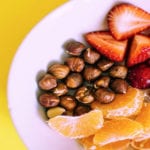We need to provide healthy snack time for our kids.
Food is a fuel. It can embody the conditions of the heart, our mood. It fulfills our needs—physically, psychologically and emotionally. Simply, it’s a salve to the body and spirit.
Food can serve as a strong symbolism to our daily encounters. It makes a good representation of culture, gender, and age. Even of social status. It can reflect the festivity of a celebration. If not, the adversity of one’s household. And at times, food perfectly illustrates the kind of person we are inside and out.
The complexity of preparing a snack
Preparing food, on the other hand, tells a different story. Parents struggle every day to balance nutrition and taste, not to mention the demands of their critics—the kids.
The food table turning into a battlefield is a typical scenario. Parents always want to prioritize health and budget. Meanwhile, kids and teenagers hurdle for tastes and trends. Who wins? In most cases, no one. Why is that? Because parents can be pressured to just serve what the kids wants. And children, even now eating what their hearts desire will sooner or later suffer the consequences of an unhealthy meal.

Amanda A. Kostro Miller of Fitter Living and a licensed dietician/nutritionist, says:
“Westernized nations live in an overfed and undernourished society. Many children, especially those in low income areas, have access to minimal healthy food options that are within their budget. Cheaper snack options that are often available in schools are chips, candy, pastries, sweetened/flavored milk and sugar-sweetened beverages.
Also, you have to take into account how peer pressure, especially for more independent, older kids plays into a child’s food choices. Kids may go with their peers for a soda, a basket of fries or gas station hot dogs after school. Unfortunately, many food options available to children tend to have significant calories, fat, sodium and sugars.”
Some households have a different dilemma. With the many food available in the market, parents find it hard to choose which really is wholesome. Having fruity or leafy pictures in the packaging does not help at all. Even labels such as “organic”, “sugar-free”, or “natural” can be suspicious at times.
If you are a parent, you know how tough it is to prepare a kid’s meal. Or is it? In this article, we wanted to share to you healthy snack options your kids will love. First, let’s tackle food that should never be in your counter.
Parents vs unhealthy snacks
Unhealthy food is a snare. Especially to the younger population, the baits used by the manufacturers behind them are proven effective. It plays with the senses which later on affects our purchase decisions.
Snare #1: Unhealthy snacks are usually packed attractively. They use harmful vivid and popping colors in the packaging or the food itself to make it inviting. For instance, chips are usually yellow or orangey, while soda drinks are in various fruit flavors—pink for strawberry, green for lime and apple, or violet for grapes and mixed berries.
Moms can also be tricked. Most snacks are disguised as “healthy”. They may use pictures or labels that does not represent the food content at all such as putting the words “vegetable snack” when only a small amount of vegetable is there. Or worse, they are just green food coloring.
Solution: “An eye for an eye.” The best thing you can do is to be keen. Look at the packaging, but more on the nutrition facts. There, you can have a balanced perspective of what the whole thing is. Of course, you can always do a little research on terms used there.
You can also change the way you plate snacks. Looks are important to kids, too. Let them fall in love with your food though passing to their kiddie standards.
Snare #2: Unhealthy snacks are enticing to the palate. Taste-wise, kids prefer processed nibbles than what usually parents served with love. Sad, right? Their dark secret is on the artificial flavorings added. And while not all are harmful, most of them post health risks when taken at a certain amount.
Solution: Play with flavors. Healthy foods are not always bland. You just have to know what flavors complements each other. Natural flavorings are always the best. In fact, they are better than artificial ones as they can capture texture as well.
Snare #3: Unhealthy snacks are “convenient” and “budget-friendly.” Considering only the present, unhealthy snacks are always available almost everywhere. Most of them don’t cost much. I mean, the amount you purchased for a liter of soda drink may still be insufficient to buy a pure cranberry juice. Tendency when on a tight budget? They’ll go for the cheaper. After all, it can also quench the thirst.
In the long run, nutritious options are always the most convenient. Not only you can avoid the hardship of caring for an ill family member, you will also be saved from the expenses behind that.
Solution: Think that all decisions have future consequences. It’s easy to disregard details in decision-making. After all, it’s just a snack. But taking care of details give favorable results. We are not just talking about the family’s health. How you handle everyday decisions can also affect your kid’s view of things.
Unhealthy popular children’s snacks
Your kids may be eating the unhealthy snack options. We’ve consulted some experts and here’s what they don’t suggest eating:
Pre-packaged or processed snacks
Melissa Morris of QuickQuote said, “Most pre-packaged or processed snacks are the unhealthiest ones because they tend to be higher in sugar, fat, and sodium. They are also low in nutrients and do not contribute to feeling full. Examples are cookies, fruit snacks, chips, and juice boxes.”
A lot of parents, understandably so, rely on pre-packaged snacks for their kiddos. While these can be good options, the vast majority are, unfortunately, not. According to nutritionist Aubrey Phelps of Back to Scratch LLC, “Most pre-packaged snacks are high in sugar, processed carbohydrates, and unhealthy, inflammatory fats/oils. Chips, granola bars, fruit bars, fruit snacks, flavored yogurt tubes – these are primarily processed carbs and added sugars, which leads to increased blood sugar levels (not good!), and kids that are hungry again in a matter of minutes! Fat and protein are super important, as well as fiber, both to manage blood sugar levels, but also to help kids stay full and satisfied. Goldfish crackers, pretzels, graham crackers, raisins, most cereals – these are all common snacks, but really aren’t ideal.”
Instant foods
As parents, it can be difficult to squeeze in a nutritious meal every time but that does not mean that unhealthy snacks are the way to go. Nutritionist Vasundhara Agrawal recommends avoiding snacks like packaged fruit juices, boxed cereals & mac n cheese, gummies, candies and frozen chicken nuggets or fish fingers. She says, “These foods are nutritionally poor and packed with added sugar and hence they do not meet the nutritional and growth requirements of your child.”
Snacks with artificial coloring
Let’s face the facts straight on. The popular but unhealthy children’s snacks are the ones with artificial color. Take, for instance, Cheetos. In one taste test, people were asked to evaluate a batch made without artificial yellow coloring that turns the snack—and our fingers—orange. Their brains did not register much cheese flavor from the crunchy gray snack. Sometimes, the color will tell the brain to override our taste buds.
Mira Dessy of the Ingredient Guru and the author of the Pantry says, “Today, artificial colors are a petroleum product. Yes, petroleum, as in related to gasoline. This is not a substance that provides any health benefits whatsoever.” Yikes!
Chewy snacks
Chewy snacks are another harmful food to avoid giving to children. This is especially to save their teeth. Dentist Summer Holloway of Floss Dental Boutique says, “Teeth can have some very deep grooves on the biting surface, especially baby teeth. Typically snacks are a highly processed, effortless go-to food that easily get stuck in those deep grooves. Any snack that tends to be sticky or chewy has a higher propensity to increase the risk of early childhood decay. Types of snacks that are popular but that I do not recommended from a decay perspective include: chewy fruit snacks, fruit-by-the-foot, gushers, cookies, goldfish, cheez-it, and sticky candy.”
Snacks loaded with sugar and sugar sweetened beverages
As parents, many of us struggle when it comes to a healthy and well-balanced diet. What is healthy VERSUS what they like or will eat. This doesn’t mean that you don’t give them sweets or any other treats once in a while; it only means that you reduce their intake of unhealthy foods to a bare minimum, and make them snacks that are sweet, healthy, and filling.
Dr. Piper Gibson of Regenerating Health said, “Some unhealthy foods include sugar-filled and or processed items that include: pop-tarts, sodas, donuts, cereal, juice, snack cakes (think Little Debbie), chips, muffins, ice cream, candy, and cookies. This sugary processed foods contain little nutritional value and they are full of empty calories.”
There are SO many snacks that look healthy and are loaded with good for you buzzwords, but how do you know that they’re actually healthy for your kids? One thing to always look for is sugar content. New nutrition labels now all list the added sugars that are in foods and no healthy snack should contain more than 5g of added sugar per serving.
To check sugar content, Dr. Kristen Richardson of PrimeLife Nutrition urges, “Look for ingredients like fructose, corn syrup, brown rice syrup, etc. because not everything on a label is actually listed as simply as sugar. The ingredients should also be minimal and you should understand what all of those ingredients are. If the ingredients are super scientific and seem like mostly chemicals, they’re probably not a great choice. Look especially for anything that’s hydrogenated, as that’s a trans-fat which can lead to heart health issues later down the line.”
Amanda A. Kostro Miller, a licensed dietician/nutritionist adds, “In general, parents should be conscious of limiting added sugars, saturated fats and sodium from the child’s diet. Added sugars are often found in fountain drinks, sports drinks, candy, juice drinks, sweets, snack food items. Saturated fats are often found in fried foods, processed foods (i.e. processed meats), fast food.” –
Foods high in sodium
Sodium is a common ingredient in snacks. While it enhances taste, excess levels of sodium/salt may put your children at risk. Food that are packed with sodium are fast food, processed food, chips, crackers, and pretzels. You should avoid them at all costs.
Caffeinated drinks
Childhood and adolescence are the most important stages for your kid’s growth and development. Unfortunately, when you give them snacks with high caffeine, you deprive them of getting proper nutrition for growth. It can also dehydrate your child. To avoid these, don’t give them coffee, tea, iced tea, chocolate drinks, cola and fruit flavored juices.
Fried, greasy, and high calorie foods
Too much grease can upset your child’s stomach. It also has high calorie, since it is cooked in oil. You can start avoiding these health risks through not eating fries, fried meats, doughnuts, hamburgers and pizza.
Healthy Snacks for Children
It’s easier to avoid unhealthy when there are alternatives. Moms can choose among these, or try all of them one snack at a time!
Snacks rich in fiber and protein

Healthy snacks should include at least two food groups and be minimally processed. Melissa Morris says, “The best options also include fiber and protein, both of which help keep you full longer. Examples include low-fat yogurt with strawberries, peanut butter with celery, mozzarella cheese with apple slices, or carrots with hummus.”
Teeth and cavity-friendly food
Summer Holloway recommends these healthy snack alternatives that will also decrease your child’s risk of cavities: applesauce, hard cheese, fruit, celery with peanut butter, salami, almonds, hard boiled eggs, and carrots.
Whole fresh foods

Doctors focusing on whole fresh foods like meats, fruits, and veggies. Dr. Piper Gibson says, “Get outside the box, the processed food box that is and focus on eating nutrient-dense whole foods.”
According to Aubrey Phelps, “Snacks should really contain two of the three macronutrients (carbs, protein, fat); fat/protein, fat/carbs, carbs/protein. No NAKED carbs! So, an apple isn’t really a snack, but an apple with a cheese stick or peanut butter? That is! This helps stabilize blood sugar and keep kids feeling fuller/satisfied longer (avoiding that nagging request for infinite snacks throughout the day!).
Try to choose real, whole foods, like fruits and vegetables, nuts, seeds, etc. as the main focus of the snack. Some great snack options include: carrot sticks with hummus, bell pepper slices with guacamole, banana slices with peanut butter, apple slices with sunbutter, cashews with raisins, cheese stick with a clementine, dried seaweed snack with avocado slices, goldfish crackers with cheese cubes, and graham crackers with almond butter.”
Healthy snacks in the market
For snack ideas that you can buy in the market, Dr. Kristen Richarson has some recommendations:
- Perfect Bar for Kids
- KIND mini’s,
- Larabar mini’s,
- PURE layered fruit bars,
- Pirate’s Booty,
- Bark Thins,
- BARE apple chips and other fruit chips,
- Unsalted and no sugar added trail mixes
To help parents who struggle to find healthy snacks for their little ones, here are some recipes that can kickstart the better snacking habits of your family!
Recipes of Healthy Snacks for Kids
(by Nutritionist Vasundhara Agrawal)
These are extremely healthy, rich in protein & good fats and without any added sugar. They can be a great evening snack or something to munch on and can be packed in our kid’s lunch boxes too.
Ingredients:
- ½ cup dates
- 2 tbsp chopped walnuts
- 2 tbsp almonds
- ½ to 1 tbsp cocoa powder
- a pinch of salt
Procedure:
- Add all the ingredients in the processor/ mixer. Pulse them till they are sticky and form a dough consistency.
- Take it out and make a dough.
- Divide it into 4 balls and give it a shape like a cookie.
- Keep them in the freezer for 5 mins to set.
- Serve them cold.
Fruit Skewers

(by Dr. Piper Gibson)
This is a colorful and healthy snack that takes only minutes to prepare and is a great way to get your kids to eat more fruit. You can involve your kids in the entire preparation process as it is easy.
Ingredients:
- 14 blueberries
- 7 red grapes
- 7 green grapes
- 7 peeled pineapple pieces
- 7 peeled kiwifruit pieces
- 7 tangerine pieces
- 7 cubes peeled mango
- 7 hulled strawberries
- 7 raspberries
Equipment:
7 skewers
Procedure:
Thread the fruits onto each skewer in the following order: 1 raspberry, 1 hulled strawberry, 1 tangerine piece, 1 mango cube, 1 pineapple piece, 1 peeled kiwi piece, 1 green grape, 1 red grape, and 2 blueberries. Arrange in a rainbow-like arch and serve.
Fruit And Nut Yogurt

This is an energy-boosting breakfast snack that is a great alternative to cereal and will also keep your kids full till lunch.
Ingredients:
- 6 tablespoons chopped mixed nuts
- 2 tablespoons pumpkin seeds
- 2 tablespoons sunflower seeds
- 2 sliced bananas
- 4 handfuls berries (quantity can vary depending on your needs)
- 400g vanilla yogurt
Procedure:
Mix the nuts, pumpkin seeds, and sunflowers seeds together. Mix also the sliced bananas and berries. Divide them into two and layer them up in two bowls containing the yogurt and serve.
Sunbutter cups
Ingredients:
- 10 pitted dates
- ¼ cup sunflower seed butter
- 1 to 2 tablespoons raw cacao nibs
- ½ cup rolled oats
- 1 tablespoon hemp seeds
- dash of sea salt
Procedure:
- Add all the ingredients to a blender or food processor until well mixed.
- Form into balls and store in the refrigerator in an air-tight container.




